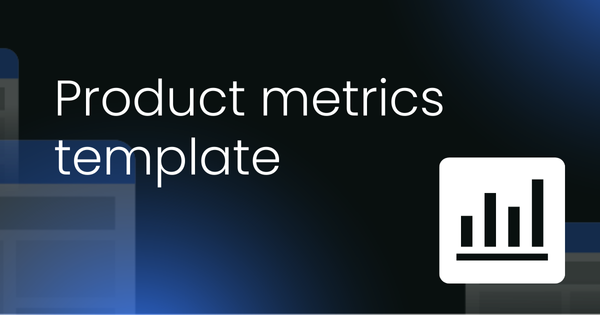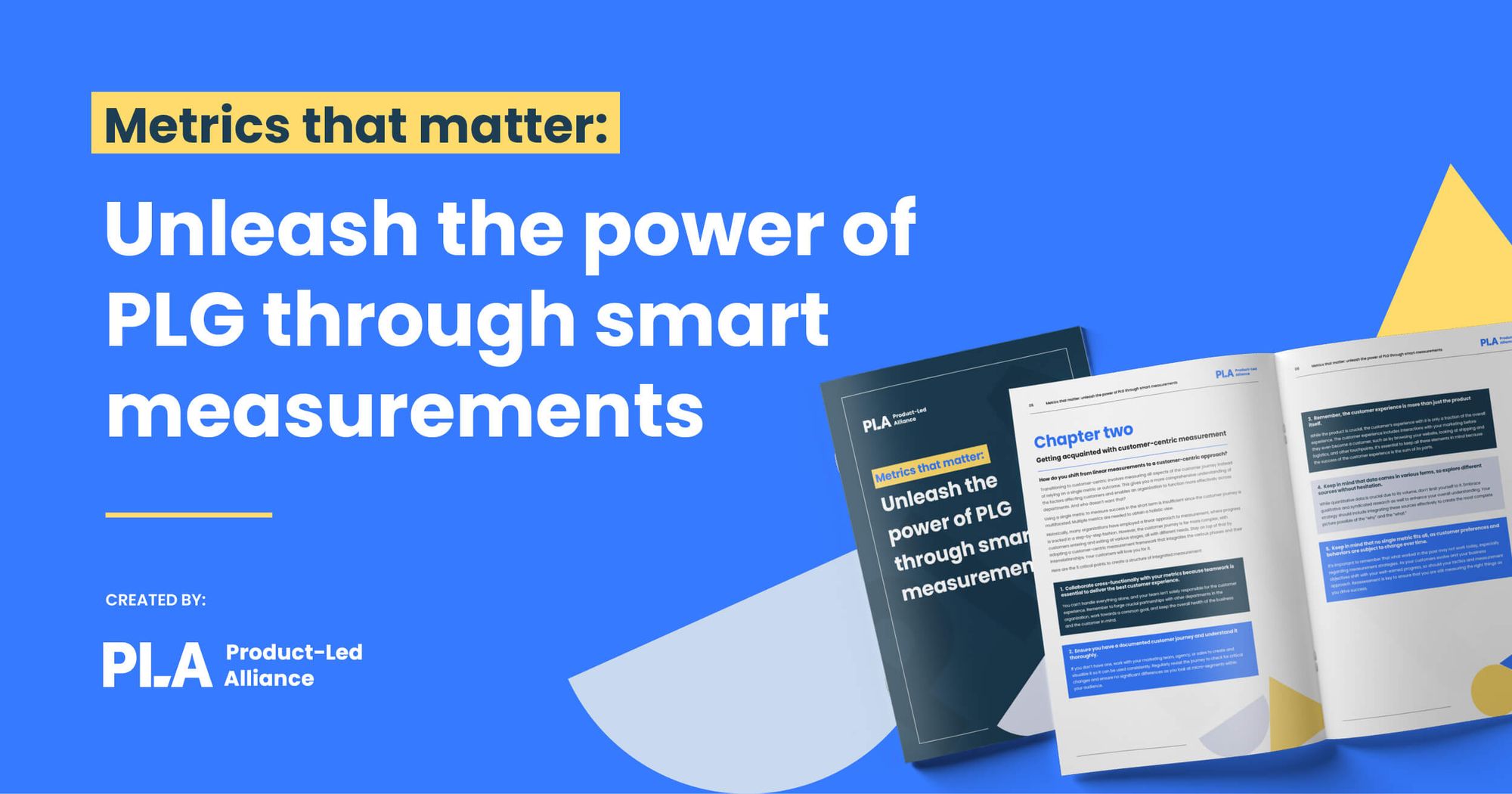Your product is your baby, and you need to take care of it so it can grow and thrive. But how do you go about that? How do you know if your product is hitting the right milestones so it’s evolving to the best it can be?
The right metrics will guide you to make the right choices for your business, and as a product manager, it’s your job to know which ones are best to follow. We’ve made a nice little hub for all the top metrics in product management right now, how to choose the best ones for you, and what they look like in practice.
- Why use metrics
- Metrics vs measurements
- Choosing the best metric for you
- Metrics:
- Time to Value
- Feature Adoption Rate
- Product Qualifying Leads
- Expansion Revenue
- Customer Retention
- Conclusion
Why use metrics in product management?
Outside of the obvious that metrics allow you to measure your business’s health, there are a few important reasons why you need to stay on top of them.
Firstly, product metrics keep your business focused on performance and growth. When you look at data, you can see where your business is dragging, and can identify changes that need to be amended. Metrics give you specific goals to tailor your business plan for success.
Secondly, metrics give you accountability by setting targets. When you know what goals you’re trying to make, keeping everyone on track to hit them becomes a lot easier. It also makes for happy employees when you keep those goals realistic, based on hard data, rather than pulling numbers out of thin air.
Thirdly, metrics give valuable insight into good decision-making. By understanding trends and how to use the market to your advantage, data can inform strategic planning. Rather than throwing things at the wall and seeing what sticks, be targeted in your approach with the best knowledge to make good choices.

PLG metrics vs measurements
Let's chat about metrics vs. measurements – it's like comparing apples and, well, an entire fruit salad. Metrics are your cool, big-picture pals – they tell you if you're winning the game. Think monthly active users, conversion rates, the real MVPs. On the flip side, measurements are the nitty-gritty details, like the pixels on your product canvas. They're the 'how many clicks here' and 'time spent there' kind of detectives.
So, while metrics are the rockstars headlining the show, measurements are the backstage crew making sure everything runs smoothly. Balance is the name of the game; it's not just about hitting the numbers but understanding the dance between metrics and measurements that paints the full picture of your product's growth journey.
Choosing the best metrics for your product-led growth strategy
Choosing which metrics to follow requires knowing your business inside and out. What are your goals, where are you right now, and where do you want to be in the future? That can seem intimidating, especially if you’re at the beginning of your product journey. But don’t worry, we’ve got a handy little acronym to help get you started.
Ever heard of SMART? It’s a simple guide to brainstorming your goals and choosing the right KPIs for you. Remember to check back on these every so often as your business grows and your needs change.
S: Specific
Specific KPIs are focused on reducing misinterpretation. They are straightforward so that everyone can act on them without confusion.
M: Measurable
You want data that’s presented in qualitative forms. Thinks numbers and percentages, which are easy for everyone to read and understand.
A: Achievable
Are the goals you set from the data collected attainable? Can your employees work towards them feasibly?
R: Realistic
Are the KPIs suitable for your business growth?
T: Time-bound
KPIs that reflect a certain time period for your goals.
What are the most important product-led growth metrics?
We’ve finally gotten to the coveted metrics. By now, you should have a good idea of why you need to monitor your product’s growth, so here are a few product KPIs you can track. Keep in mind this isn’t an exhaustive list by any means, but will give you a nice direction to begin your metrics journey.
Time to Value (TTV)
Time to value is a crucial measurement to monitor. It’s how long it takes for a customer to find value in your product. By understanding the time frame of value a customer gets, you can help identify how to optimize your onboarding experience for a quicker ROI. And a quicker ROI means you’re less likely to have customer churn.
Why? Because people’s attention spans are the shortest they’ve ever been. And if you don’t hook them as quickly as possible, you might lose them to the competition.
Your number one goal with TTV is to reduce it.
But before we learn how to do that, it’s important to understand the five types of TTV.
- Time to basic value: The moment a customer finds the lowest value from your product.
- Time to exceed value: The amount of time for your product to exceed a customer’s expectation
- Long time to value: Products that take longer for customers to figure out and get value from. This can create friction if the onboarding is complicated and timely.
- Short time to value: When your product solves your customer’s problem quickly
- Immediate time to value: When you deliver instant gratification
In order to measure TTV, you can look at a few things.
- How long it takes someone to go from a free trial to subscribing.
- How long it takes for the customer to be onboarded.
- How long does it take someone to use a new feature once you make them available?
So how do we reduce TTV? A few ways! The best thing you can do is minimize the onboarding experience. Customers want gratification as soon as possible, so the more barriers you put between them to getting it, the more likely you are to lose them.
You can also include onboarding emails to guide someone as they try your product out. Think of this as holding their hand so there’s no confusion about the product and what it offers them. Similarly, an in-app guide can create checklists and walkthroughs to clearly show customers what benefits you offer without overwhelming them.
If your onboarding isn’t optimized, you need to reduce friction. That’s taking out anything that could trigger a potential customer to walk away, whether from an emotional standpoint or something with design.
Lastly, if your product can allow it, personalize the onboarding experience. Nothing catches a customer quite like a tailored experience. It makes the product feel more personal and brings in more emotional value.
Product Qualifying Leads (PQL)
PQLs are a fairly new metric, and many companies are still in the early adoption stages with it. In fact, only one in four SaaS companies use PQLs, despite all the benefits tracking this metric can offer.
So, what is a PQL? A PQL is a potential client who has seen value in your product, usually after a free trial or freemium and is ready to convert to a paying customer.
This isn’t to be confused with Market Qualifying Leads (someone who had a meaningful interaction with the product) or a Sales Qualified Lead (someone who inquires or looks for information about purchasing the product). PLQ convert to sales 15-30% more than MQLs and SQLs because they’re a step further in the acquisition funnel. These are the people primed to buy.
It's important to understand that PQLs should reflect your product, so as your product changes, so should your PQLs. This isn’t a one-size fit for all every business. You need to understand your needs for this metric to work for you.
Why track PQLs? These leads need very little convincing to buy your product and have a lower customer acquisition cost. They’ve already found value and just need a little push to become a paying customer. Curious about how to identify them? The best way is to consider what actions customers take right before purchasing.
- How much usage does a customer get before the free trial or freemium runs out? Do they experience value at this time? Is it long enough to convert them
- Use of a certain feature: What are customers using most frequently before they buy?
- What milestones do customers hit before buying?
A few PQL Metrics to consider:
- Raw PQL: the number of PQLs you generate in a certain time period. You can focus on weekly vs. monthly, depending on your product.
- Time to PQL: the amount of time it takes someone to become a PQL.
- PQL Conversion Rate: Number of converted PQLs divided by the total number of PQLs.
Benefits of tracking PQLs include the creation of the ideal customer profile, a shorter sales cycle, and a lower churn rate.
Feature Adoption Rate
One of the best metrics for understanding your product’s relevance is feature adoption rate. This is the percentage of people who use or adopt a new feature once you’ve rolled it out. It’s calculated easily enough if you have time on your side. Most companies divide the monthly active users by the total number of users that year.
The higher your feature adoption rate, the less likely a customer is to drop your product, meaning overall retention is higher. As each feature should add more value to your product, if a customer isn’t using them and are paying for it, perceived value diminishes.
What are the best metrics to watch for this?
- Breadth of adoption: How many people have adopted the new feature across the whole platform? This shows overall interest.
- Depth of adoption: How often does someone use a new feature? Are they using the feature as designed and intended? Feedback is crucial here to understand stickiness and relevance.
- Time to adopt: How long does it take for someone to start using a new feature? When someone adopts a feature quickly, it means it solving a problem for them therefore the feature value is higher.
- Duration of adoption: How long does someone use a new feature after first starting it? Retention highlights value beyond novelty.
To increase feature adoption, use in-app announcements. Make apparent the value of new features and use targeted communication. Not everyone will use every aspect of the product, so keep it as streamlined as possible.
Expansion Revenue
Expansion revenue is all about growth. This metric is the revenue a customer generates after initially purchasing a product and is usually tracked over a month. Monthly tracking lets you see how much your business grows over time. This metric doesn’t include new customers.
There are four main ways of expanding revenue beyond the initial product:
- Upselling: When a customer buys more expensive products, usually at a higher quality point that includes more features.
- Cross-selling: When a customer buys an additional product, usually one that is complimentary to the initial purchase.
- Add-ons: When Customers purchase additional features that enhance the product they are currently using.
- Reactivation: When a customer who’s previously canceled a plan renews their subscription.
To expand your monthly revenue, you must understand your customer’s relationship with your product, test different price points and embrace feedback when it’s given. When your expansion revenue increase, so does your Customer Lifetime Value. The more customers repeat purchases or upgrades, the higher value they get from your services. These clients will most likely stay with you long-term and generate lots of income.
To calculate your expansion revenue, you must subtract the old revenue value from the total new revenue of an existing customer.
Reducing friction is one of the best ways to encourage additional purchases. Make the choice to buy bigger and better products easy for your customers. It’s 6-7 times more expensive to onboard new customers, so tapping into your existing base is the most cost-effective way to draw in more income.
Customer retention metrics
Customer Retention Rate is all about loyalty and building longevity. But first and foremost, you need a product that will have a customer going crazy for it. Once you’ve created your empire and the services you will sell to fund that kingdom, it’s your job to monitor and maintain your constituents.
So how do you measure customer retention and that oh-so-coveted loyalty? Read on to find out!
Surveys
You can send out a few surveys to get a qualitative measurement of customer satisfaction and loyalty. We’ll focus on the two biggest, but remember these surveys are versatile and can be outfitted to ask whatever you feel is essential to your business.
Customer Satisfaction Score (CSAT)
CSAT measures happiness when it comes to a product or service. This is done by asking simple questions like, “How satisfied were you with your service today?” usually on a scale of 1-10. Don’t feel restricted to using a scale like this. Want to use emojis or measurements like, “satisfied” or “unsatisfied”? Go right ahead. The flexibility of surveys is what makes them so appealing. The point is to derive a quantitative measurement from feedback, so as long as you get an average, the questionnaire has done its job.
Surveys can be delivered in several ways and depend on how you usually contact your customers. The most popular are websites, emails, and kiosks if your business is brick-and-mortar.
CSAT gives your customer’s a chance to offer direct feedback, so it’s important to remember to use this information well. Are customers disappointed in something? Now is your opportunity to reprimand it and improve your CSAT for next time.
Net Promoter Score (NPS)
Very similar to CSAT. Although while CSAT measures happiness, NPS measures loyalty through how likely a customer is to recommend your product to others. Again, the scale is optional for how it’s structured, but if you want to get the most from your survey, follow up with questions expanding on your product. Why would your customer recommend it? What about it appeals to them? The more you ask, the better picture you’ll have of what’s working and not working for you.
You need the proper software to conduct surveys and a good schedule to run them. Some of the best software today are Qualtrics CoreXM, SurveyMonkey, and Google Workspace, among others. Over-surveying your customers can create fatigue and annoyance. Use them sparingly but in the moment. Asking for feedback months after a transaction won’t be beneficial to you, but pestering a customer every time they do business with you will get old fast.
Having a high NPS means you’ll most likely have good word of mouth, which can be used to indicate company growth. Strong word of mouth means free advertising, so don’t skip out on this metric.

Churn Rate
Most companies measure churn rate monthly. Churn is the amount of business you’ve lost in a given time period and offers insight into your customers' behavior. When tracked over many months, you can see trends where your customers are abandoning ship and can address why that is.
Churn is calculated by dividing the number of customers lost at the end of the month by the total number of customers at the start of the month, times a hundred. Your goal for churn should always be zero, but when is that ever feasible? Aiming for 5-15% is a reasonable rate and allows you a window to predict revenue loss.
To ensure company growth, churn rate can’t exceed revenue. Otherwise, you’re in hot water. That’s why assessing customer acquisition cost is essential when factoring in churn rate. Can you afford to onboard a new customer if they may potentially leave down the road? Remember, keeping your existing customers is cheaper, so this metric should be top propriety.
Customer Retention Rate (CRR)
Since we’re on the topic of retention, let’s look at that very metric itself. Customer retention rate is the number of customers who remain doing business with you after a given time. This is one of your best loyalty indicators and is mainly used with products that have a long lifespan.
To calculate, you divide the number of customers at the end of a time period by the number of customers from the beginning, then multiply by a hundred. In a perfect world, you’d have 100% CRR, but realistically, and depending on your industry, you’d probably aim for around 80%.
Increasing your CRR by just 5% can improve your ROI by 25% and upwards. It's way easier to cross and upsell products to an already loyal base than to sell to someone new. You’ve already built brand trust, so getting more out of your customers is easier this way. And happy customers who see value in your product are more likely to recommend it to others. It’s a win-win situation just waiting for you to grab it.
Conclusion
There are more than enough metrics out there, but these few cover a wide range of topics and can help you build a strategic plan for your business the right way. So, if you’re feeling overwhelmed, just remember that each metric here is meant to help and guide you, and you only have to use the ones that apply to your business goals. So, take time to experiment and explore and see what works best for you!




 Follow us on LinkedIn
Follow us on LinkedIn





